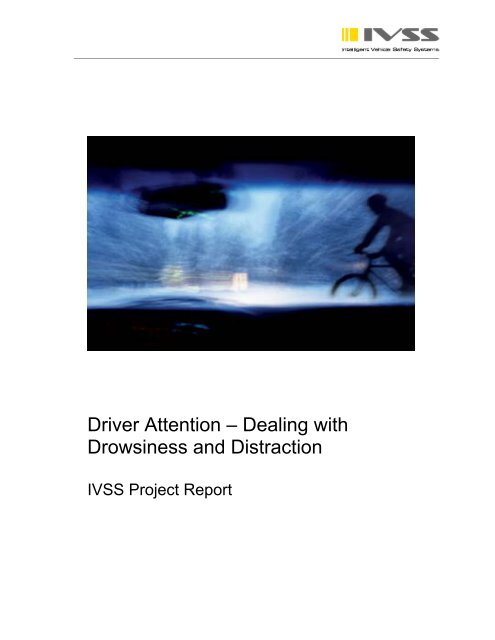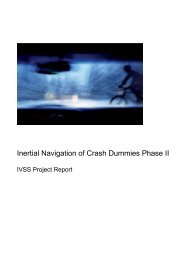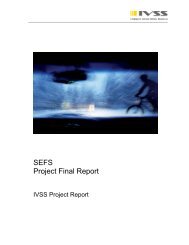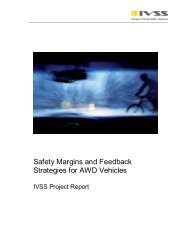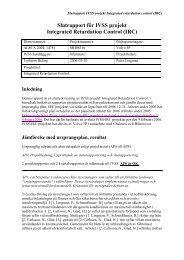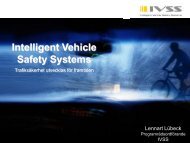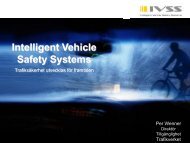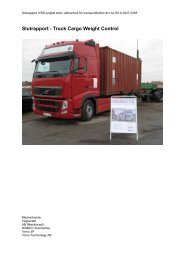7. Fulfilment of IVSS objectives - IVSS Intelligent Vehicle Safety ...
7. Fulfilment of IVSS objectives - IVSS Intelligent Vehicle Safety ...
7. Fulfilment of IVSS objectives - IVSS Intelligent Vehicle Safety ...
You also want an ePaper? Increase the reach of your titles
YUMPU automatically turns print PDFs into web optimized ePapers that Google loves.
Driver Attention – Dealing with<br />
Drowsiness and Distraction<br />
<strong>IVSS</strong> Project Report
The <strong>IVSS</strong> Programme<br />
The <strong>IVSS</strong> programme was set up to stimulate research and development for the road<br />
safety <strong>of</strong> the future. The end result will probably be new, smart technologies and new IT<br />
systems that will help reduce the number <strong>of</strong> traffic-related fatalities and serious injuries.<br />
<strong>IVSS</strong> projects shall meet the following three criteria: road safety, economic growth and<br />
commercially marketable technical systems.<br />
Three interacting components - for better safety, growth and competitiveness:<br />
The human being<br />
Preventive solutions based on the vehicle’s most important component.<br />
The road<br />
<strong>Intelligent</strong> systems designed to increase security for all road users.<br />
The vehicle<br />
• Injury prevention<br />
• Crash avoidance<br />
<strong>IVSS</strong><br />
Active safety through pro-active technology.<br />
• Product excellence<br />
• Premium requirements<br />
• Cost<br />
2<br />
• Business growth<br />
on a global market
Project Partners:<br />
Title <strong>of</strong> the report: Driver Attention – Dealing with Drowsiness and Distraction<br />
Author: Arne Nåbo, Saab Automobile AB<br />
Reference number: AL 80 A 2008:73471<br />
Publication date: 2009-04-07 Issue 1.<br />
Contact person: Arne Nåbo<br />
3
Table <strong>of</strong> contents<br />
Summary<br />
Sammanfattning<br />
1. Introduction ............................................................................................................... 7<br />
2. Project objective ........................................................................................................ 7<br />
3. Functionality <strong>of</strong> the AttenD system ......................................................................... 8<br />
4. Field Operational Test ............................................................................................ 10<br />
5. Results ...................................................................................................................... 11<br />
6. Industrial prospective ............................................................................................. 12<br />
<strong>7.</strong> <strong>Fulfilment</strong> <strong>of</strong> <strong>IVSS</strong> <strong>objectives</strong> ................................................................................ 13<br />
8. Conclusions and recommendations ....................................................................... 13<br />
9. Publications ............................................................................................................. 14<br />
10. Presentations ........................................................................................................... 14<br />
4
SUMMARY<br />
Loss <strong>of</strong> control is a fact if the driver diverts from the driving task for just a few seconds.<br />
A continuous attention to driving is a must in order to drive in a safe way. But it is also<br />
known that humans are easily being distracted or drowsy.<br />
The project overall objective was to contribute to traffic safety by promoting an alert and<br />
attentive driver by technical means in the vehicle. A Driver Attention system was<br />
developed with the purpose to detect and warn the driver in case <strong>of</strong> visual inattention and<br />
sleepiness. By monitoring head- and eye behaviour with a remote eye tracking system,<br />
indicators <strong>of</strong> drowsiness and distraction, such as gaze direction and eye blinks, was<br />
measured. An Inattention Detection Algorithm was developed and worked as follows; A<br />
“field relevant for driving” was defined that would correspond to the most important road<br />
scene. When the drivers’ eye gaze was within this field he was considered to be attentive.<br />
For the inattention algorithm the driver had a buffer <strong>of</strong> two seconds which could be spent<br />
looking at targets outside the field relevant for driving. When the buffer was empty, a<br />
warning was given by vibrations in the seat. The detection <strong>of</strong> drowsiness was based on<br />
the eye blink behavior. The longer the eye blinks were and the more <strong>of</strong>ten they occurred,<br />
the more drowsy was the driver. The warnings were classified in three levels; slightly<br />
drowsy, drowsy and very drowsy, and were given by text- and speech messages.<br />
Field operational tests were done in order to evaluate the system. Seven drivers used an<br />
instrumented Saab 9-3 in their daily lives for about a month each, and four pr<strong>of</strong>essional<br />
drivers used a Scania truck in long-haul delivery runs for two weeks each.<br />
In the passenger car, the results <strong>of</strong> using the system do not show very large effects, but<br />
those that appear tend to go into the “right” direction, meaning that a distraction warning<br />
could have positive effects on driving safety and does not seem to have negative effects.<br />
Drowsiness warnings were not evaluated in the passenger car due to very few warnings<br />
and these were not experienced as correct.<br />
In the truck, as a main result, inattention warning turned out to decrease the number <strong>of</strong><br />
prolonged inattentive periods in drivers. Results also indicate a tendency for drivers to<br />
drive drowsier when using a drowsiness warning system. In contrast, the truck drivers<br />
exhibited no clear behavioral adaptation effects in response to distraction warning.<br />
An industrial prospective was carried out in order to guide the continued development <strong>of</strong><br />
drowsiness and distraction mitigation systems to production readiness.<br />
5
SAMMANFATTNING<br />
För att säkert framföra ett fordon krävs en kontinuerlig uppmärksamhet på vägen. Redan<br />
vid ett par sekunders distraktion kan föraren ha förlorat kontrollen över körningen. Men<br />
det är också känt att människor har svårt att upprätthålla koncentration och vakenhet<br />
under längre perioder utan att bli distraherade och sömniga.<br />
Det övergripande syftet med projektet var att bidra till ökad trafiksäkerhet genom att med<br />
ett tekniskt system i bilen hjälpa föraren att hålla uppmärksamheten på vägen. Ett sådant<br />
system utvecklades med syfte att varna föraren vid visuell ouppmärksamhet och<br />
sömnighet. Genom att övervaka huvud- och ögonbeteende med ett kamerasystem mättes<br />
indikatorer på distraktion och sömnighet, såsom blickriktning och blinkningar. En<br />
algoritm för visuell ouppmärksamhets togs fram, där först en ”zon relevant för körning”<br />
definierades såsom det vägområde som är viktigt för körning. När förarens blick var inom<br />
denna zon betraktades föraren som uppmärksam. Sedan definierades en<br />
”uppmärksamhetsbuffert” som tillät föraren att ha blicken utanför denna zon i två<br />
sekunder utan att få en varning. När bufferten var tom fick föraren en varning genom att<br />
sätet vibrerade. Detektion av sömnighet baserades på förarens blinkningar. Ju längre<br />
blinkningar och ju <strong>of</strong>tare dessa förekom, desto sömnigare förare. Sömnvarningar gavs i<br />
tre nivåer, något sömnig, sömnig och mycket sömnig, i form av text- och<br />
talmeddelanden.<br />
För att utvärdera systemet genomfördes fältstudier. Sju förare körde en instrumenterad<br />
Saab 9-3 i fyra veckor var ”som om den vore deras egen” och fyra lastbilschaufförer<br />
körde en Scania långtradare i två veckor var i vanlig drift. Resultatet av försöken i<br />
personbilen visar inga stora effekter av användandet av systemet, men de som finns<br />
tenderar att gå i ”rätt” riktning, dvs. att distraktionsvarning kan ha en positiv effekt på<br />
körsäkerhet och verkar inte heller ha några negativa effekter. Sömnvarningen<br />
utvärderades inte då antal varningar var få och dessutom inte upplevdes som korrekta. I<br />
lastbilen så visade resultaten att distraktionsvarningen minskade antalet långa<br />
distraktioner. De indikerar också att det finns en tendens att förarna kör mer sömniga när<br />
det finns en sömnvarningsfunktion. Däremot syntes inga tecken på att förarna ändrade<br />
beteende på grund av av distraktionsvarningen.<br />
I projektet gjordes även ett industriellt prospekt med syfte att vägleda fortsatt utveckling<br />
av varningssystemet till industriell tillämpning.<br />
6
1. Introduction<br />
Loss <strong>of</strong> control is a fact if the driver diverts from the driving task for just a few seconds.<br />
A continuous attention to driving is a must in order to drive in a safe way. But it is also<br />
known that humans are easily being distracted or drowsy. These traffic safety problems<br />
have received lot <strong>of</strong> attention lately. Several recent studies indicate that about 10-20 % <strong>of</strong><br />
all accidents are likely sleepiness-related, and distraction has been a contributing factor <strong>of</strong><br />
up to 78-80% <strong>of</strong> all accidents and incidents.<br />
Recently, systems are introduced on the market that will mitigate this problem by<br />
managing the drivers’ workload (examples: the ComSense in Saab and the IDIS in<br />
Volvo). The purpose <strong>of</strong> these systems is to eliminate or suspend potentially distracting<br />
information in high workload situations, and by that avoid secondary tasks to be in<br />
conflict with primary driving tasks. These systems can mitigate the distraction originating<br />
from the use <strong>of</strong> in-vehicle systems but can not detect other kinds <strong>of</strong> distraction.<br />
The intention <strong>of</strong> this work was to take another step in drowsiness and distraction<br />
mitigation by using newly matured remote eye tracking systems. By monitoring head-<br />
and eye behaviour, indicators <strong>of</strong> drowsiness and distraction, such as gaze direction and<br />
eye blinks, can be measured.<br />
2. Project objective<br />
The project overall objective was to contribute to traffic safety by promoting an alert and<br />
attentive driver by technical means in the vehicle. A Driver Attention system – in this<br />
project called ‘AttenD’ – was developed with the purpose to detect and warn the driver in<br />
case <strong>of</strong> visual inattention and sleepiness.<br />
The following specific <strong>objectives</strong> were defined:<br />
1) Develop and install a “Driver Attention system” (AttenD) in a Saab car and a<br />
Scania truck.<br />
2) Develop measures <strong>of</strong> system effectiveness and user acceptance.<br />
3) Develop test methodology for “small-scale field operational test.<br />
4) Industrial prospective. How to go from prototype system to industrial application.<br />
7
3. Functionality <strong>of</strong> the AttenD system<br />
The primary input to the AttenD system came from a Driver Monitoring System (DMS)<br />
consisting <strong>of</strong> two cameras directed towards the drivers face.<br />
Figure 1. A schematic overview <strong>of</strong> the Driver Monitoring System (SmartEye Pro).<br />
An Inattention Detection Algorithm was developed and worked as follows; A “field<br />
relevant for driving” (FRD) was defined that would correspond to the most important<br />
road scene. When the drivers’ eye gaze was within this field he was considered to be<br />
attentive. For the inattention algorithm the driver had a buffer <strong>of</strong> two seconds which<br />
could be spent looking at targets outside the field relevant for driving. When the buffer<br />
was empty, a warning was given by vibrations in the seat. The buffer was filled when the<br />
driver looked back at the FRD.<br />
8
Figure 2. The ”field relevant for driving(FRD)” as seen from above, provided that the<br />
driver looks through a window.<br />
Figure 3. Representation <strong>of</strong> the decrease <strong>of</strong> the attention budget for three consecutive<br />
one-second glances away from the “field relevant for driving” (FRD), marked red, with<br />
half-second glances back to the FRD in between. Warning is activated at -5 s.Between -<br />
1.8 s and 0 s a 1.8-s-glance to the mirror or speedometer is shown, where a delay in<br />
buffer decrease is allowed as it is a driving related task.<br />
The detection <strong>of</strong> drowsiness was based on the eye blink behavior. The longer the eye<br />
blinks were and the more <strong>of</strong>ten they occurred, the drowsier was the driver. The warnings<br />
were classified in three levels; slightly drowsy, drowsy and very drowsy, and were given<br />
by text- and speech messages.<br />
The AttenD system also included a warning management function with the objective to<br />
“filter out“ unnecessary warnings, such as avoid repeating the same warning, or to inhibit<br />
warnings when the driver is doing excessive maneuvering like hard braking or steering.<br />
9
Figure 4. Video recording, actual example from test drive. Upper left; view from front<br />
camera on road scene. Upper right; camera view on driver and instrument panel. Lower<br />
left; map showing the location <strong>of</strong> the vehicle. Lowe right; Screen shot from the logging<br />
computer showing status <strong>of</strong> system and history <strong>of</strong> log data.<br />
4. Field Operational Test<br />
Simulator studies have shown that it is difficult to attain “true distraction” in an artificial<br />
setting and researchers who have performed such tests recommend using a field test for<br />
further evaluation <strong>of</strong> distraction mitigation systems. This recommendation led to the<br />
decision to perform a field test, using the general methodological setup <strong>of</strong> a field<br />
operational test (FOT), but on a smaller scale than common for this type <strong>of</strong> test.<br />
Seven drivers (4 males and 3 females) used an instrumented Saab 9-3 in their daily lives<br />
for about a month each. During the baseline phase, which consisted <strong>of</strong> the first<br />
approximately 10 days, the driver was not given any feedback on his behaviour; the car<br />
“behaved” just like a normal car. The driving behaviour, including warnings that would<br />
have been given, was logged. During the treatment phase, which lasted for the remaining<br />
10
approximately 20 days, logging continued, and warnings for inattention and drowsiness<br />
were not only logged but also given to the driver. The drivers’ subjective opinion about<br />
the warning system and their expectations and experiences were obtained via a set <strong>of</strong><br />
questionnaires and by interviewing the drivers.<br />
Four male drivers, from two transportation companies engaged in long-haul delivery<br />
runs, participated in the Scania field tests. The experiments were run for one week per<br />
condition (without and with warnings to the driver), a total <strong>of</strong> two weeks for each<br />
participant, which yielded around 40-50 hours <strong>of</strong> total driving time per participant. As a<br />
comparison, the Saab-study generated similar amounts <strong>of</strong> driving hours per participant.<br />
The same data as in the Saab study was collected.<br />
5. Results<br />
Generally the method used in the present study appears to be suited for investigating<br />
driver distraction. A substantial number <strong>of</strong> distraction cases were logged. The automatic<br />
eye tracking worked well over a prolonged time period without intervention by the<br />
experimenter. The quality <strong>of</strong> the tracking was constant over time, and the very varying<br />
lighting conditions did not adversely affect tracking. The data acquisition system worked<br />
as planned in principle, even though stability issues have to be solved in future studies,<br />
and a better power management is required for further and more large-scale studies.<br />
Passenger car:<br />
Generally, the experiences with the participants were positive, and the procedure used<br />
seemed to have worked for all involved. The large variation between participants for<br />
many <strong>of</strong> the analysed performance indicators shows clearly that the number <strong>of</strong><br />
participants was too low to draw any definite conclusions about the effect <strong>of</strong> the<br />
distraction warning system. The data from the present study suggest that the warnings do<br />
not have an immediate effect such that the driver looks up faster after having received a<br />
warning than without warning. It does not appear, either, that drivers try to avoid the<br />
warnings, because for most <strong>of</strong> the drivers the warning frequency did not decrease<br />
measurably. There is no increased concentration <strong>of</strong> glances in the field relevant for<br />
driving, or an increase in PRC values (Percent Road Center) in the treatment condition.<br />
Neither does the distribution <strong>of</strong> gazes change from the baseline to the treatment phase.<br />
The only possible change could be found for the duration <strong>of</strong> individual glances, where it<br />
seems like the percentage <strong>of</strong> very long glances decreased in the treatment phase.<br />
Furthermore, the number <strong>of</strong> times the attention buffer returned to zero before filling up<br />
completely after a warning appears to have decreased.<br />
Thus, the results do not show very large effects, but those that appear tend to go into<br />
the “right” direction, meaning that a distraction warning could have positive effects<br />
on driving safety and does not seem to have negative effects. The few effects that<br />
appeared did not change much over time. This might indicate that there is no noteworthy<br />
11
learning curve, even though it is too early for a definite statement on this question. The<br />
absence <strong>of</strong> a learning effect implies that the distraction warning has approximately the<br />
same effect already during the first experiences with the warning as it has later on.<br />
In the passenger car study there are no analyses <strong>of</strong> the drowsiness data because the<br />
drivers received only very few drowsiness warnings, and they reported that they did not<br />
experience those as correct.<br />
Truck:<br />
The AttenD system proved to operate well in the field tests. As a main result, inattention<br />
warning turned out to decrease the number <strong>of</strong> prolonged inattentive periods in drivers 1.<br />
Results also indicate a tendency for drivers to drive drowsier when using a drowsiness<br />
warning system 2 . In contrast, drivers exhibited no clear behavioral adaptation effects in<br />
response to distraction warning.<br />
6. Industrial prospective<br />
An industrial prospective was carried out in order to guide the continued development <strong>of</strong><br />
drowsiness and distraction mitigation systems to production readiness. This is the<br />
content <strong>of</strong> the report (21 pages, restricted to project partners).<br />
1 Introduction<br />
2 System performance requirements<br />
2.1 Performance requirements overview<br />
2.2 General performance requirements<br />
2.3 Specific focus on Drivers wearing glasses<br />
2.4 Methodology to assess system performance and validate the system<br />
3 System components and cost (computer platforms, sensors.)<br />
3.1 Definition <strong>of</strong> a computer platform<br />
3.2 Sensor 13<br />
4 Integration in vehicle (packaging, electrical interface, robustness)<br />
4.1 Sensor In-vehicle physical implementation<br />
4.2 Sensor packaging<br />
5 Manufacturing<br />
5.1 Calibration procedures<br />
6 Short Business case study<br />
6.1 Competitors and form <strong>of</strong> the competition<br />
6.2 Products that may compete<br />
6.3 Market risks and plan to mitigate them<br />
6.4 Potential market<br />
1 We found one exception with the last driver that was tested: This driver happened to drive during night<br />
when systems were turned <strong>of</strong>f, and drove during daytime when the systems were turned on.<br />
2 The last driver exhibited more drowsiness in the systems-<strong>of</strong>f condition, when driving during night.<br />
12
<strong>7.</strong> <strong>Fulfilment</strong> <strong>of</strong> <strong>IVSS</strong> <strong>objectives</strong><br />
Road safety: Regarding system performance it shows indications on positive results (less<br />
inattentive drivers when using the system). However, the design <strong>of</strong> the field test was not<br />
optimal in terms <strong>of</strong> evaluating system effectiveness, as it was difficult to identify what<br />
were correct alarms, false alarms and misses. This is a draw-back in performing field<br />
tests (no - or little control <strong>of</strong> what is happening). To study system effectiveness requires a<br />
more controlled experiment set up. (This was identified as important follow-up<br />
activities.)<br />
The system tested shows good potential for user acceptance. Most drivers were positive<br />
to the system and the experience <strong>of</strong> using it. This shows a good potential for high usage<br />
when the system is put on the market.<br />
Economic growth: As all partners were actively engaged in the project work it has<br />
resulted in continued development and planning within each organisation respectively.<br />
Also, a number <strong>of</strong> new joint projects that build from the result <strong>of</strong> this project has been<br />
identified and started at Swedish competence centres and research programs (ViP-<br />
VisualEyes and FFI-Driver Drowsiness- and Distraction Detection by SensorFusion.)<br />
Commercially marketable technical systems: One part <strong>of</strong> the project was an industrial<br />
prospective. Besides pointing out the most important system performance requirements, it<br />
also described other quality- and production issues, such as how to integrate the systems<br />
in the vehicle and how to plan for production. (See chapter 6.)<br />
8. Conclusions and recommendations<br />
Conclusions:<br />
The results do not show very large effects, but those that appear tend to go into the<br />
“right” direction, meaning that a distraction warning could have positive effects on<br />
driving safety and does not seem to have negative effects.<br />
The automatic eye tracking worked satisfactory for the test period, but improvement <strong>of</strong> its<br />
performance is highly recommended for the specific conditions that were found.<br />
The test procedures for the passenger car were successful in contrast to the truck test<br />
procedures that were less successful. In particular, the truck instrumentation turned out to<br />
be under-dimensioned, with frequent overload <strong>of</strong> the USB-connections and resulting<br />
signal loss.<br />
Recommendations:<br />
For field operational test it is recommended to have a greater number <strong>of</strong> vehicles running<br />
in parallel in order to collect more data on more test participants and to better control for<br />
seasonal variations.<br />
13
Another learning is that robust power management for test systems and data logging<br />
systems is needed. The best would be to use automotive specifications for these<br />
components.<br />
Analysis <strong>of</strong> the collected data on a more detailed level would be beneficial. Due to<br />
resource limitations this was not done within the scope <strong>of</strong> this project.<br />
Regarding system performance it was concluded that improvement <strong>of</strong> the distraction<br />
algorithm in order to decrease the overall number <strong>of</strong> warnings and <strong>of</strong> course especially<br />
the false and nuisance warnings have to be found.<br />
9. Publications<br />
Boverie, S. et.al. (2008). Driver Attention - Dealing with Drowsiness and Distraction:<br />
Industrial prospective. Restricted report. Toulouse, France: Continental Corporation.<br />
Kircher, K. (2007). Driver distraction: A review <strong>of</strong> the literature (VTI Report No. 594A).<br />
Linköping, Sweden: VTI (Swedish National Road and Transport Research Institute).<br />
http://www.vti.se/templates/Report____2796.aspx?reportid=8034<br />
Kircher, K., Kircher, A., Claezon, F. (2009). Distraction and Drowsiness Field<br />
Operational Test: Technical Report (VTI Report No. 638A). Linköping, Sweden: VTI<br />
(Swedish National Road and Transport Research Institute).<br />
http://www.vti.se/templates/Report____2796.aspx?reportid=11165<br />
Kircher, K., Kircher, A., Ahlström, C. (2009). Results <strong>of</strong> a Field Study on a Driver<br />
Distraction Warning System (VTI Report No. 639A). Linköping, Sweden: VTI (Swedish<br />
National Road and Transport Research Institute).<br />
http://www.vti.se/templates/Report____2796.aspx?reportid=11167<br />
Kovordányi, R., Kollegger, P., Claezon, F., Granlund, R. (2008). <strong>IVSS</strong> Driver Attention -<br />
Dealing with Drowsiness and Driver Distraction: Field Operational Test <strong>of</strong> two Warning<br />
Systems using an Instrumented Scania Truck. Linköping, Sweden: Department <strong>of</strong><br />
Computer and Information Science, Linköping University.<br />
10. Presentations<br />
Swedish-American Chambers <strong>of</strong> Commerce. Lidköping. August 21, 2006.<br />
Transportforum 2008. Linköping. January 9, 2008.<br />
Press Event with test driving. Södertälje. October 23, 200<strong>7.</strong><br />
<strong>IVSS</strong> and V-ICT Temadagar. Göteborg. December 10, 200<strong>7.</strong><br />
<strong>IVSS</strong> Temadag. Göteborg. March 27, 2008.<br />
14
BilSweden ”Den olycksfria bilen” Seminar. Stockholm, April 4, 2008.<br />
NORBIT 2008<br />
Driving Assessment Conference 2009.<br />
15
<strong>IVSS</strong> partners:<br />
Postal address: <strong>IVSS</strong>/Swedish Road Administration, SE–781 87 Borlänge, Sweden<br />
Street address: <strong>IVSS</strong>/Swedish Road Administration, NAVET, Lindholmspiren 5, Gothenburg, Sweden<br />
Phone: +46 (0)771 119 119<br />
ivss@vv.se<br />
www.ivss.se


